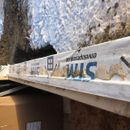Window installations
Its good practice to create a sill pan flashing prior to installation of a window?
After contacting most all major peal stick membrane suppliers I find none of their products are to be used with “standing water” or are warrantied at all with this application! They tell me water must shed. Its difficult to impossible to shed water off a flat sill surface.
Shimming the sill to slope places the window out of plumb and jeopardizes the warranty.
Am I looking to use sheet metal of some kind or?
Cheers
GBA Detail Library
A collection of one thousand construction details organized by climate and house part











Replies
Homeflash,
It's not only good practice, here it is required by code.
Sill pans need to be installed on a sloped sill so any moisture can drain to the exterior. To provide a flat base for the windows use sloped shims.
Hi Homeflash.
I think most high-performance builders install both a back dam and a sloped sill. You can see how to do that in this article:Installing Flangless Windows.
Keep in mind that this flangeless window is different than a flanged window install, though. Though the sill is prepped the same, once the window is set, in most flanged window installs, the bottom flange is not taped to the sheathing. That way, water than runs down the sloped sill has a way out.
All of our windows come with a subsill to allow the water to drain away, the last thing you want is water in the building structure
Ya, lots of manufactures say a lot of things. If you're concerned about the longevity and waterproof capability, perhaps look into a liquid based flashing.
Your window gets plumed by the installers with a level. It's not reliant on the thing that it's sitting on. Sloped sill or not, you're still adding shims at the bottom anyway to level the window (and leave a gap for drainage). So you might as well slope the sill and not have to worry about standing water issues. If you're still worried about the plumbness then use wedge shims like Malcolm suggested, the same degree your sloped your will you can counteract that degree with the opposing shim on top of the sill.
Jamie